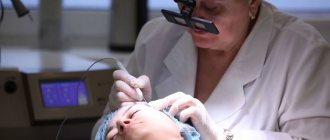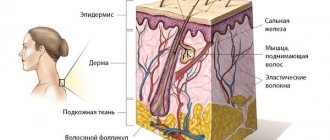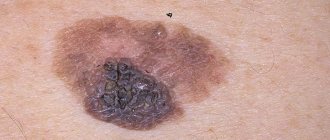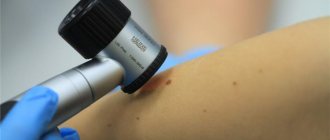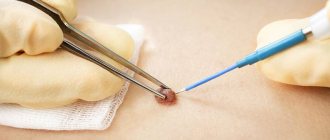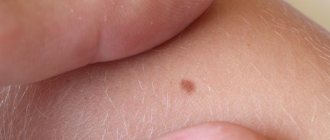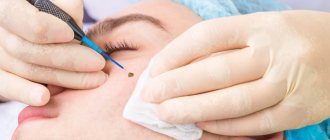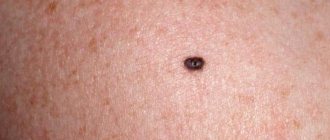It often happens that we injure moles. Rip off completely or slightly tear off from the skin. It happens that the bleeding is quite strong, but it is still possible to stop it. Here the mole is covered with a band-aid and everything seems to be fine. Here we remember that in childhood our mother told us: “Don’t pick at a mole - you can die from it.” With an unpleasant feeling somewhere in the upper abdomen, we begin to search on the Internet for the eternal answer to the question “What to do?” After half an hour or an hour we understand that in a couple of days death from melanoma will occur and it’s time to look for a place in the cemetery...
Later in this article I will try to interrupt the endless stream of hysteria that has been copied from site to site for many years
Sign up for the webinar “Carcinogens in cosmetics: truth, lies and... marketing”
Is mole injury really dangerous?
In RuNet, the danger of traumatizing moles is given excessive, in my opinion, importance. Is there any justification for this point of view? Absolutely, but I think it's quite shaky.
Indeed, there are several studies on this issue, mostly conducted in the 60s–80s of the last century. They show that 30–50% of patients in whom melanoma developed against the background of a nevus noted single or repeated trauma to the mole.
There are several arguments against these studies:
- Just because melanoma develops after trauma to a nevus does not necessarily mean that the two are related. Melanoma could develop both before trauma and much later for other reasons .
- A 2010 meta-analysis (summarizing data from 9 studies) showed that performing an incisional biopsy does not affect the prognosis of melanoma. In other words, if a piece is cut off from melanoma (for diagnostic purposes), this will not negatively affect the patient’s chances of living 5 years or more.
- The conclusions of the authors of several studies (55, 115, 147 and 498 patients) agree on one thing - incomplete removal of nevi, except for dysplastic ones with severe dysplasia, does not lead to the development of melanoma.
Here the corrosive reader will say: “Aha! Still, incomplete removal (you can read “trauma”) causes the development of melanoma!” No. A dysplastic nevus with severe dysplasia itself has a high chance of becoming melanoma in the future. The connection between incomplete removal and the development of melanoma from such nevi has not been proven .
- My experience. Almost every day people write to me who have injured a mole and are now preparing to “die” because they have read too much on the Internet. Almost any person who has a mole protruding above the skin has injured it in one way or another at least once in their life. If trauma to a mole were really a risk factor, in our country with a population of 146,000,000, the diagnosis of melanoma would be made much more often than 8,000 times a year.
Injury to a mole: consequences
First of all, it should be noted that the development of melanoma is not always associated with damage to pigmented nevi and will not necessarily be a consequence of such a process. At the same time, doctors have proven that for moles that are initially classified as melanoma-hazardous, any trauma to their surface can lead to accelerated development of the cancer process. This is one of the main reasons why any nevi should be protected from aggressive damaging influences.
In addition to malignant transformation, we can identify several more unpleasant and dangerous consequences that a torn or torn off mole can entail:
- Heavy bleeding. The body of the nevus feeds many blood vessels and capillaries, which saturate the formation cells with oxygen and nutrients. Some moles, such as angiomas and hemangiomas, are composed entirely of a tangle of blood channels. It is in this regard that if a mole is damaged, severe bleeding can develop, which can most often be stopped only with the help of professional medical care. After visible healing, the mole often bleeds for a long time, which is a residual consequence of the injury.
- Attachment of infection. An open wound that forms at the site of a damaged nevus provides rapid access for infectious agents to the wound surface and, accordingly, to the entire patient’s body. As a result, not only a local infectious process can develop, but also a generalized pathological condition, accompanied by suppuration of the primary site of contamination.
- Inflammatory process. Often after mechanical trauma to a nevus, patients note swelling of the area around the mole and some hyperemia of the skin. This, together with pain when pressed, may indicate the development of inflammation. Such a reaction is sometimes accompanied by vasospasm, which is manifested by the appearance of a white spot around the torn mole. In the absence of professional medical care, such a process can also lead to suppuration of the wound.
- Formation of scars and scars. This aspect is especially concerning for the fair sex, because a situation where a woman scratches a mole on her face with a massive accessory or manicure is not uncommon. The consequence of such a careless attitude towards a nevus can be an undesirable aesthetic defect, which is formed against the background of excessive formation of connective tissue. In the future, such scars and scars can only be removed using hardware cosmetology techniques.
In order to avoid all these unpleasant phenomena, it is recommended to treat existing moles with care and attention and remove a defect located in an area of increased risk of injury in advance.
What will happen to the mole next?
After trauma, as in any other place, the mole will hurt a little and turn slightly red - this is normal. Gradually, after 2-3 weeks, these phenomena should go away on their own. The only situation in which medical intervention may be required is the suppuration of a mole after a severe injury. This means that if after a few days a viscous white (not yellow) liquid begins to come out from the site of injury, you need to be examined by a surgeon. After 1-2 days, a crust will appear at the site of the injury, which will fall off on its own after 1-2 weeks.
Actions to take if a mole is damaged
Actions to take when a mole is injured depend on the nature of the damage. If the mole is slightly scratched, but there is no blood, then it is enough to wash it with an antiseptic solution. It is not necessary to see a doctor.
If there is bleeding from a mole, the following measures must be taken:
- treat the wound with an antiseptic (excluding iodine);
- moisten a cotton swab with hydrogen peroxide and apply to the mole;
- When the bleeding stops, apply a bandage.
If the mole is severely torn, then you need to go to the clinic and have the tumor completely removed. After this, it is advisable to submit the biomaterial for histological examination. If the mole has fallen off completely, then it should also be sent for histology. But melanoma does not develop so quickly, and its first signs appear about a month after the mole is injured, so it would be best to undergo a re-examination.
How to properly monitor a mole after an injury?
To objectively track changes in a mole, after the inflammation has subsided, you can take a photograph of it against the background of a ruler and compare the original image with subsequent ones. In order for the photo to be of high quality and comparison possible, the following rules must be observed:
- The photo must be taken with a camera, not a phone.
- The photo should not be a “selfie”. In such photographs, the mole is usually out of focus.
- A light source or camera flash should be directed at the mole.
We advise everyone to contact the Ufa HEALTHY SKIN CENTER
Nevi (moles) are very easily injured, especially convex and overhanging ones. Therefore, it is important to take precautions.
When sunbathing, do not expose yourself to heatstroke and sunburn! Lubricate your skin with a cream with a protective composition against ultraviolet rays. Fly to hot countries when the sun there is not so exhausting. Avoid wearing clothes that are too tight to prevent moles from becoming injured due to friction against rough fabrics.
During water procedures, use only soft washcloths. Be especially careful when handling shaving equipment.
When caring for your appearance, do not pull out or pluck hairs from moles - shorten them with scissors.
Consult a dermatologist and it is better to remove moles located in places of potential injury: on the chin, chest, abdomen, and in the perineal area. It is better to plan the removal procedure for autumn or winter, when the exposure to ultraviolet radiation on the operated skin is minimal.
Keep an eye out for newly appearing moles. You should be alarmed if they begin to grow unexpectedly quickly, change their color, shape, or crack, peel, or hurt. Don't be lazy, see a doctor!
Address: Russia, Republic of Bashkortostan,
Ufa, st. Revolutionary, 70
Briefly about the main thing:
In my opinion, there is currently no convincing evidence that trauma to a mole can lead to the development of melanoma. Besides me, oncology associations such as NCCN and ESMO also think the same. However, I don’t know if everything was fine with your mole BEFORE the injury. That is why, after the inflammation has subsided, I recommend contacting an oncologist, especially if this specialist has not looked at all of your moles before. If pain, redness, and swelling do not go away within a month, you need to see an oncologist as quickly as possible.
If you still have questions, the following will help you:
- In-person appointment with an oncologist
(St. Petersburg) - Mole removal
with histology (St. Petersburg) - My Online consultation (from anywhere in the world)
Should I see a doctor? If yes, which one?
We have already spoken about the examination at the clinic. To be on the safe side, it's better to go.
When should I make an appointment?
There is no need to rush here - at least wait for the wound to heal and only then contact a doctor. In about three weeks.
All this time, the wound is covered with a protective crust, which interferes with diagnosis.
What to do if an injured mole takes a long time to heal?
It's important to know why. If the wound is suppurating, do not wait three weeks and immediately make an appointment with a surgeon.
Sometimes the skin just heals slowly. Due to the characteristics of the body. In this case, wait for complete recovery, and then show the healed nevus to the doctor.
Which doctor should I make an appointment with?
We have already talked about complications due to injury - this will require a visit to a surgeon. But a dermatologist checks for skin cancer. He specializes in skin diseases and identifies signs of degeneration in any tumors.
See a dermatologist if the injured mole increases in size. The growth of nevi is a dangerous sign. Large tumors are more likely to turn into cancer.
Unfortunately, the enlargement of a mole is not always noticeable.
It needs to be checked regularly.
Where does a mole begin?
Nevus is considered a benign skin neoplasm, characterized by an accumulation of nevocytes, melanin-rich cells.
This is why the mole has a dark color and fairly clear boundaries.
The transformed melanocytes (nevocytes) take up the thyroid hormone thyroxine and transform it into melanin, which colors the skin in a certain area.
Melanin is necessary for the human body.
It is both an antioxidant and a predictor of anti-stress hormones, softening emotional reactions, and a regulator of sleep and wakefulness.
To be or not to be a mole is determined in the embryonic period, even if the pigment formation appeared after birth.
Some features of pregnancy stimulate the process of melanocyte transformation.
The nevocyte does not have processes, therefore, like a stingy knight, it accumulates all the melanin without giving it to other areas of the skin. You can be born with moles or acquire them during periods of hormonal crises: puberty, pregnancy, menopause, unsuccessful selection of contraceptives.
As well as intense tanning, including in solariums, skin infections, allergies.
Nevocytes form a border nevus at the border of the superficial and deep layers of the skin. then grow into the dermis (mixed or intradermal nevus).
A border nevus is a round, dark, smooth spot.
The mixed one protrudes slightly above the skin.
An intradermal nevus looks larger, rising like a dome on a small stalk, sometimes with hairs, that is, it looks like a dark wart.
The main danger of a nevus is that its cells can become malignant and malignant.
Melanoma, a very dangerous malignant skin tumor, can develop from a melanocytic nevus.
80% of deaths from skin cancer occur with melanomas, although almost all patients who receive timely treatment live quietly for 10-15 years before a new relapse.
Risk factors for malignancy are known.
These are heredity (melanoma or other oncology), ultraviolet radiation (permanent or excessive tanning), sunburn, fair skin and red hair.
Gella, the heroine of The Master and Margarita, could have a predisposition to melanomas.
Let's look at some complaints related to moles.
Self-medication is unacceptable
When a child scratches a mole, trying to treat it yourself is highly inadvisable, since such procedures can cause serious harm by introducing infection into the damaged area. The main complication in this case is the development of malignant processes, which are caused by pathological transformation of the cellular structures of the nevus.
It is for this reason that every person, if possible, should visit a doctor who will carry out the necessary diagnostic measures to examine the mole, which will help identify the presence of certain diseases.
In what cases is it necessary to remove an injured nevus?
The injured growth must be urgently shown to a specialist and removed if it is very painful, brings discomfort, has changed color, shape and size, bleeds, itches, or discharge appears in the form of pus and ichor.
A damaged nevus does not always develop into cancer; it depends on its individual structure. After treatment or removal of a torn mole, experts advise monitoring it and if there is the slightest change in the damaged area of the dermis, go to the hospital.
To ensure prevention of injury to warts and birthmarks, you should not scratch them, wear comfortable, loose, well-tailored clothes without rough seams, use soft washcloths, and pat the skin with a towel rather than rubbing it. If formations are injured, do not self-medicate.
The appearance of a crust on a mole
The growth on the nevus may be white or brown. This crust appears when there is an injury or burn. If a mole begins to crumble, the result may be skin cancer. You cannot peel off the crust yourself, as this can lead to infection of the skin. To exclude nevus transformation, it is necessary to undergo dermatoscopy by a dermatologist or oncologist. This is the diagnosis of skin lesions using special optical equipment - the procedure is absolutely painless, does not require preparation and takes no more than 10 minutes.
If the doctor finds suspicious symptoms, a biopsy will be required. In this case, a small area of skin is taken for analysis in the laboratory.
Why does blood come from a mole?
If you scratch a mole and it bleeds, this is a very bad sign. If everything is fine with the mole, it does not grow and does not change its appearance and color, then there is no need to touch it. However, if it is profusely engorged with blood or bleeding occurs from the nevus, this is a sign of a certain pathology that must be clearly diagnosed. A healthy formation will not bleed, so if blood comes from the nevus, it means it is injured.
Sometimes it happens that you scratch a mole without bleeding.
Removal techniques
If the doctor decides to remove a mole, this can be done using the following modern techniques:
- surgical removal;
- removal with nitrogen (cryodestruction);
- electrocoagulation;
- laser therapy;
- radio wave excision – getting rid of a mole using high-frequency waves.
Surgical removal is considered the most reliable method for removing damaged moles. The surgeon cuts off the formation with a scalpel and cauterizes the wound. Then an antibiotic and a special bandage are applied to the surface. Sometimes the mole and its surrounding surface are removed. The size of this area affects the possibility of developing a malignant process. After cutting out large areas, stitches are placed.
The cryodestruction method is used for small moles and papillomas in prominent places. Using an applicator, liquid nitrogen is applied to the mole, where a bubble appears. It subsequently shrinks and forms a crust, which then falls off and new skin remains in place. Dermatologists confirm this. What to do if you scratch a mole, you should first check with them.
Electrocoagulation fights annoying moles, warts, HPV, acne and many other ailments. When removing a mole with an electric coagulator, the specialist selects the power of the device and, using a loop-tip, begins to influence the mole through an electric current.
Laser therapy is suitable for removing small tumors. Today, this procedure is recognized as the most effective method for removing a mole on the face. Its essence is the complete elimination of education. To remove a mole without damaging surrounding areas of the skin, a beam with a certain wavelength is selected. Its effect is aimed at melanin, which is contained in moles.
First aid if a mole is ripped off
If a mole comes off, it is necessary to treat the wound. The formations are damaged during shaving and hair removal and are partially torn off. If there is bleeding, you need to treat the wound and stop the bleeding. Doctors advise doing the following:
- Rinse the damaged area of skin thoroughly with hydrogen peroxide to stop the bleeding.
- Disinfect the wound using antiseptics (Miramistin, Zelenka, Iodine, Chlorogexidine, Fukortsin solution, Chlorophyllipt). When treating damaged areas of the skin with Miramistin or Chlorogexidine, you should use a sterile cotton swab. If another medicine is chosen to disinfect the wound, it is applied pointwise; the injured area must be cauterized so as not to touch the healthy dermis.
- After treatment, a sterile bandage or patch is applied to the area.
If the pain from partial damage or a cut of the nevus does not go away within 24 hours, the patient should visit a dermatologist.
If the patient accidentally picks off a mole with her nails or jewelry and completely separates it from the skin, the wart is preserved and taken to a medical institution for analysis to determine the absence or presence of cancer cells.
Dermatologists advise smearing the injured area with Levomekol ointment or Rescuer cream, which promotes healing. The products can also be used after burns; they regenerate the dermis. The crust formed after the healing of a torn nevus cannot be removed on your own; you need to wait until it falls off.
Doctors do not recommend using the traditional method to remove a damaged mole that has not completely come off. Do not bandage the area of the tear with a thread; this can have dangerous consequences for the patient’s health.
Sometimes, when nevi are damaged, doctors are forced to prescribe glucocorticoids to the patient - hormonal drugs in the form of ointments to eliminate itching, pain, swelling, and stop inflammatory and purulent processes. To treat torn, fallen off growths on the dermis, mixed type medications are used that have antibacterial and antifungal properties (Flucinar or Lorinden). The drugs are prohibited for use by women during pregnancy.
Symptoms of violation of the integrity of a mole
If painful sensations or a feeling of discomfort appear, it is necessary to urgently take measures aimed at establishing the causes and further treatment of the phenomenon on the epidermal surface. Several of the most common symptoms of general nevus disorders:
- the skin has uneven edges around the formation;
- signs of asymmetry in the shape of the mole appeared;
- the color of the nevus has changed;
- increase in size of formation;
- the occurrence of pain or discomfort.
Treatment
When a person scratches a mole until it bleeds, in modern clinical medicine these problems are solved in several available ways:
- electricity;
- laser removal;
- cauterization.
Together with any of the methods described above, the patient can get rid of nevus on the skin and eliminate the pain that is often observed with injuries and diseases of moles.
So, I scratched the mole until it bled. The doctor will tell you what to do.

